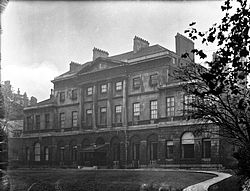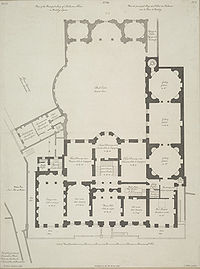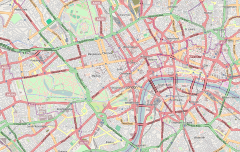Lansdowne House
| Lansdowne House | |
|---|---|
 The house before its eastern front rooms were demolished | |
| General information | |
| Architectural style | Neo-classical |
| Location | 9 Fitzmaurice Place London, W1 |
| Country | United Kingdom |
| Coordinates | 51°30′30″N 0°8′44″W / 51.50833°N 0.14556°W |
| Client | John Stuart, 3rd Earl of Bute; William Petty, 2nd Earl of Shelburne |
| Design and construction | |
| Architect(s) | Robert Adam |
| Website | |
| Official website | |
Invalid designation | |
| Reference no. | 1066795 |


Lansdowne House now 9 Fitzmaurice Place is the remaining part of an aristocratic English town house building to the south of Berkeley Square in central London, England.[a] The initial name was for two decades Shelburne House, then its title matched its owning family's elevation to a higher peerage in 1784. In the mid to late 19th century, it was frequently let, as a whole, to families of very high wealth or income, such as Lord Rosebery and Hannah de Rothschild of Mentmore Towers from 1878 to 1890.[1] Some of its 18th-century interiors, among the best in London, were taken elsewhere. It was at different times leased by three 19th century British prime ministers, and William Waldorf Astor, 1st Viscount Astor of Cliveden House, widely believed to be the richest man in America at the time of his tenancy (1891–1893) and also by Harry Gordon Selfridge in the 1920s. Landsdowne's heirs sold the property in 1929, two years after the death of the 5th Marquess, a prominent government frontbencher (cabinet minister).
The local authority had built an approach road in 1931 which saw the loss of approximately half of the rooms of its greater wing;[b] it is today one of two buildings which open onto Fitzmaurice Place but is known as 9 Fitzmaurice Place.[c] The surviving extent was granted Grade II* Listed Building status in 1970.[2] The house was also the inspiration for Bingham House in Montreal, built by Lord Shelburne's great friend William Bingham in 1821, who was then the wealthiest man in North America and an associate of Alexander Hamilton.[3][4]
Notable guests have included Benjamin Franklin, Oscar Wilde, Henry James, and the Comte de Mirabeau, among others.[5]
Current use[edit]
It houses the Lansdowne Club in Mayfair.[2] It co-serves as an address of Fitzmaurice House Ltd, the International Wine and Food Society which may meet here and The Junior League of London.
History[edit]
It was designed by Robert Adam as a house for John Stuart, 3rd Earl of Bute but in 1763 he sold it (one year into its building) to William Petty, 2nd Earl of Shelburne (both men became Prime Minister); the structure was finished in 1768.[2] Adam commissioned the local sculptor Thomas Carter the Younger to carve the chimney-pieces of his design.[6] Shelburne retained Adam until 1771, when his wife died, with parts of the decoration still incomplete. George Dance the Younger (in the 1790s of George III's reign) and Robert Smirke (at the end of his associated Regency) worked on the house.[2]
From 1763 to 1929, it belonged to the seniormost branch of the Petty-FitzMaurice family, elevated from 1784 to a high peerage, as Marquesses of Lansdowne.[2] In 1931, the house, in compensation seeing its extension built to the south-west, saw half of its greater original wing, the east wing, demolished to allow the street Fitzmaurice Place to be built. Since 1935, the residue accommodates the Lansdowne Club.
Winston Churchill commented that in Victorian and Edwardian London, "glittering parties at Lansdowne House, Devonshire House or Stafford House (Lancaster House) comprised all the elements which made a gay and splendid social circle in close relation to the business of Parliament, the hierarchies of the Army and Navy, and the policy of the State".[7]
Its front private garden exceeded its building's footprint but was subject to another's restrictive covenants. Its main front lay further forward and was a garden front to this green expanse (between Berkeley Square and Devonshire House's gardens). This conservation guaranteed for Devonshire House on Piccadilly open aspects (greenery-covered land save for discreet fences/railings) up to and including all of Berkeley Square. These reasons are set out in the Square's article.
In 2022, Blackstone finalized an agreement to redevelop Lansdowne House as its European headquarters.[8] Prime Minister Liz Truss called the agreement "a resounding vote of confidence in the United Kingdom as Europe’s leading financial centre."
Famous residents[edit]
Owner, resident:-
- William Petty, 2nd Earl of Shelburne (later 1st Marquess of Lansdowne), British prime minister (1782–83)
Tenants:-
- John Stuart, 3rd Earl of Bute, British prime minister (1762–63)
- William Pitt the Younger, British prime minister (1783–1801, 1804–1806)
- William Waldorf Astor, 1st Viscount Astor, widely believed to be the richest man in America at the time (1891–1893)
- Archibald Primrose, 5th Earl of Rosebery, was a British Liberal statesman and Prime Minister (1894–1895)
- Harry Gordon Selfridge, founder of the Selfridges department store
Partial demolition and dispersal of name[edit]

In the 1930s, the Metropolitan Borough of Westminster Council decided to build a road from Berkeley Square to Curzon Street, which required the demolition of all the garden front rooms of Lansdowne House. One of Adam's three drawing rooms was removed and installed at the Philadelphia Museum of Art, while the Dining Room went to the Metropolitan Museum of Art in New York City.[9] The façade was rebuilt in a modified form at the front of the reduced house; about half of the north-west corner has also been lost.
On 1 May 1935, the Lansdowne Club opened as a 'social, residential and athletic Club for members of social standing...'. It comprises the remaining 18th-century rooms plus a large 1930s extension in the Art Deco style.[10]
Many works of art, such as the Lansdowne Amazon and the Lansdowne Hercules, were also bought by American and British museums. The Lansdowne Hermes resides at the Santa Barbara Museum of Art in California. Other objects moved to Bowood House, the Lansdowne country house, where Adam had also worked, which remains in the family, though large parts of it were demolished in 1956.
A large office block, 57 Berkeley Square, with classical fronts and surrounding roads, occupies what was the garden. This still uses as line of its address the name of the old house. What is left of the house, with a 20th-century extension, is now called 9, Fitzmaurice Place.
Extensive renovations began in 2000.
Gallery[edit]
-
The room now in Philadelphia, before 1915
-
Part of the ceiling now in Philadelphia
-
The Adam room in the Lloyd's Building
-
View in 1820
-
Entrance view
Notes and references[edit]
- Footnotes
- ^ Not to be confused with 57 Berkeley Square – opposite – a much later quadrilateral office building which takes its name as an extra line of address. 57 Berkeley Square occupies the vast bulk of Lansdowne House's former garden; the rest of the House's former land was strips forming roads on all four sides of the Berkeley Square neo-classical office building and small parts of three thin houses north of 9 Fitzmaurice Place
- ^ The eastern half of the largest range, which formed the eastern wing, is where street Fitzmaurice Place runs today
- ^ A street having two numbered/named addresses: 5 and 9
- Citations
- ^ Lansdowne House, Berkeley Square, London, Mark Meredith, 2020
- ^ a b c d e Historic England. "Lansdowne Club (9 Fitzmaurice Place); formerly Lansdowne House; after which for a time Shelburne House (1066795)". National Heritage List for England. Retrieved 24 February 2017.
- ^ Lansdowne House, Berkeley Square, London, Mark Meredith, 2020
- ^ Hunt, Leslie (2004). William Bingham (1752-1804) Correspondence (PDF). The Historical Society of Pennsylvania. p. 1.
- ^ Lansdowne House, Berkeley Square, London, Mark Meredith, 2020
- ^ Dictionary of British Sculptors 1660-1851 by Rupert Gunnis p.86
- ^ Churchill, Winston (1930). My Early Life. Eland. pp. 8@. ISBN 9780907871620.
- ^ "Blackstone to develop new, expanded headquarters on London's iconic Berkeley Square". Blackstone. 8 October 2022. Retrieved 18 December 2022.
- ^ Drawing Room from Lansdowne House with elements by Robert Adam, Antonio Zucchi, Giovanni Battista Cipriani, and Joseph Perfetti on the website of the Philadelphia Museum of Art
- ^ "The Club - Lansdowne Club". www.lansdowneclub.com.
External links[edit]
- The Lansdowne Club
- Lansdowne House entry from The DiCamillo Companion to British & Irish Country Houses
- Europe in the age of enlightenment and revolution, a catalogue from The Metropolitan Museum of Art Libraries (fully available online as PDF), which contains material on this house (see index)
- Period Rooms in the Metropolitan Museum of Art , a publication from The Metropolitan Museum of Art Libraries (fully available online as PDF), which contains material on this house (see index)
- 1768 establishments in England
- Houses completed in 1768
- Former houses in the City of Westminster
- Petty-Fitzmaurice family
- Georgian architecture in the City of Westminster
- Buildings and structures in Mayfair
- Collection of the Philadelphia Museum of Art
- Grade II* listed buildings in the City of Westminster
- Grade II* listed houses in London
- Art Deco architecture in London
- Archibald Primrose, 5th Earl of Rosebery






